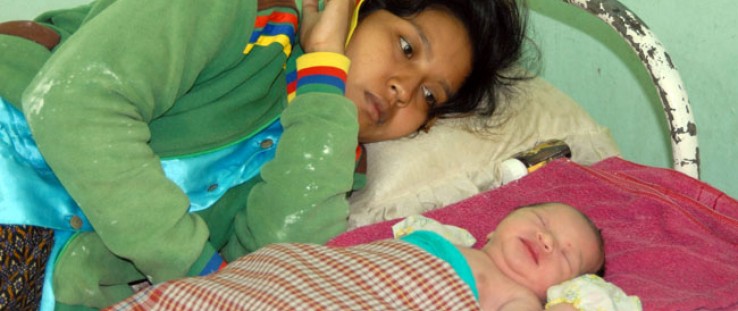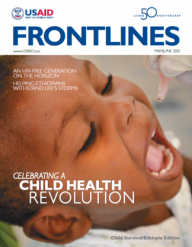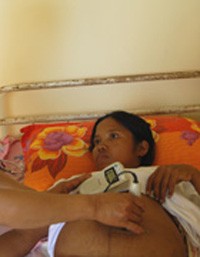 A mother with her newborn at a health center for post-partum care.
CREDIT: RHAC-TOGOH/USAID
A mother with her newborn at a health center for post-partum care.
CREDIT: RHAC-TOGOH/USAID
 A mother with her newborn at a health center for post-partum care.
CREDIT: RHAC-TOGOH/USAID
A mother with her newborn at a health center for post-partum care.
CREDIT: RHAC-TOGOH/USAID
When Sok Na, from the village of Smach Kek in rural Cambodia, gave birth to her baby at the Ream Health Center in Sihanouk province earlier this year, life looked very promising. However, three hours after her delivery, Sok began to bleed excessively.
Fortunately, she had the support of midwife Hoy Ny. Hoy suppressed the bleeding—and knew further care was needed. Trained in emergency procedures, Hoy contacted the referral hospital, requested an ambulance, and asked the doctors to prepare for the patient. Thanks to coordination and a rapid response, Sok was rushed to the hospital, where doctors were able to save her life.
Sok’s story is more common in Cambodia now than it was 10 or even five years ago. Hoy was able to apply the midwife skills that she learned through the USAID-funded Together for Good Health (ToGoH) project implemented by the Reproductive Health Association of Cambodia (RHAC), a Cambodian NGO providing health services since 1996.
Hoy said that she was happy to have been able to save her patient’s life. “I used the knowledge and skills that I learned from the RHAC trainings to suppress the bleeding. If I hadn’t learned how to do this, the patient would have died at the local health center before reaching the referral hospital. These trainings are important for us as they give us the opportunity not only to maintain strong relations, but also improve coordination between the midwives and doctors working at the referral hospital.”
The ToGoH project has been implementing a maternal and newborn health program for the last three years, promoting a comprehensive package of delivery services in community health centers. The package provides for check-ups during a woman’s pregnancy; delivery at a health center, with a minimum 24-hour stay afterward; and post-birth care to identify and prevent obstetric and newborn complications. Since 2009, over 95,000 mothers and newborns have been helped through the program. While a rigorous evaluation of the program is currently underway, preliminary data indicate that RHAC’s efforts are resulting in an increase in facility-based births as an alternative to the traditional practice of giving birth at home with an untrained birth attendant. This increase in facility-based births is recognized as a key intervention driving the dramatic decline in maternal mortality in recent years in Cambodia.
Related Content
“The program has helped increase the number of the poor women able to access birth delivery services in our health center,” said Song Narin, chief of the Sralop Health Center at the Tbong Khmum-Kroch Chhmar health district. “Before the program existed, we typically had four to 10 deliveries a month. But since the program started, in 2009, we have had around 40 deliveries a month. This support helps poor women access important life-saving services.”
The ToGoH project is active in five of Cambodia’s 24 provinces and supports 268 health centers. In 2011, skilled birth attendants managed 61,971 deliveries and conducted 42,185 post-partum visits, compared with 26,998 deliveries and 18,800 post-partum visits in 2008. In addition, 75 percent of pregnant women in the coverage area received antenatal care and services at least four times preceding delivery, compared with 46 percent in 2008.
The 2010 Cambodia Demographic and Health Survey reported a greater than 50 percent decline in maternal mortality rates in the country between 2005 and 2010. In comparison to other Asian countries, however, there is still much room for improvement.
The public sector’s capacity to provide quality maternal, newborn and child health services continues to be a challenge, as the knowledge and skill levels of primary health care staff—particularly midwives—at local health centers are limited.
Still, the effectiveness of the maternal health program is racking up positive achievements.
“In Cambodia, low-income families still face significant obstacles to accessing basic health care services,” said Flynn Fuller, USAID/Cambodia mission director. “RHAC’s program reduces these barriers to link mothers and newborns to life-saving health care.”
Hor Monika, a midwife at Prek Romdeng Health Center in Kampong Cham province, recalled a recent experience where she faced an expectant mother, Yat Da, with severe bleeding. “We were able to save Yat Da’s life by using the knowledge and skills gained from recent training. Eventually, the bleeding stopped and as she returned to a stable condition before the ambulance arrived, we decided not to transfer her to the referral hospital.”
“After Yat Da returned home, I made a follow-up visit to her home and found her in good health with no signs of complications. Furthermore, I also advised her to start using a birth spacing method,” she added.










Comment
Make a general inquiry or suggest an improvement.